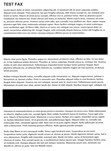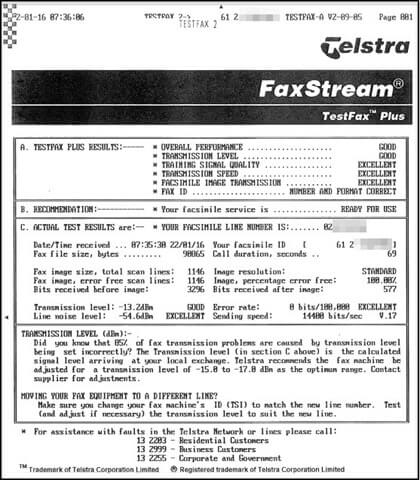Getting faxes to work over IP usually takes a disproportionate amount of time and effort in any UC / VoIP deployment. Actually, that applies to any legacy analog data: modems, dial-up EFTPOS, franking machines – they’re all doing the same thing, taking streams of 0s and 1s and turning them into a convoluted sing-song for a companion device at the other end to decode.
Assuming you have the core bits working (codecs in agreement, dial plans & timing), we Aussies have a fantastic test service available to use in Telstra’s “FaxStream”. You simply send a complex test fax to 1300 368 999 & a couple of minutes later it will send you back a report. Note that for this to succeed you need to be sending CallerID from the line, or (and I’ve not actually tested this) have the correct phone number set in your fax machine so FaxStream knows who to call back with the report!
| Not good enough | Wonderful (and actually a little bit of overkill) |
 |
 |
The Result
Where To Now?
The report above only scores a “Good” – but it kindly tells you how you can fix the problem.
The Transmission Level (at -13.2dBm) is what’s pulling the score down, and most of us would respond to this by adding some gain to the line, thinking it’s too soft and can’t be heard, when in fact we need to do the opposite: TURN THE VOLUME DOWN!
Look in your ATA/Gateway for some “gain” settings. These can be confusing, because it’s not always clear which direction the “Tx” (Transmit) and “Rx” (Receive) values are referring to, nor even if a positive value is a “gain” (increase) or a “loss” (decrease) in sound level. (My beloved old Nortel PABX family referred to these setting as “pads”, where a positive value “padded” (decreased) the level by a corresponding figure, and a negative number actually increased the level).
If in doubt, make a big change to both: if they’re currently 0, set them to -6. Re-test. No better? Try +6. Hopefully one of those tests alone should report measurable improvements in performance and you can refine it from there as appropriate.
AudioCodes m800
Sonus SBC 1k/2k
Sonus Tenor
Not Just Faxes
As I said in the opening, the headache of getting analog data reliably working over IP doesn’t just come from faxes. If in doubt (or you’re running out of ideas) – drop the transmit level from the peripheral device to the network/carrier and see what happens.
And good luck with it.
– G.
Reference: Gough Lui provides a very detailed walk-through of the FaxStream (pka ‘FOLDS’) service.








Apparently the number was changed to 1300 368 909
can you verify if this service still works as described?
Hi Steve,
1300 368 909 was historically a different service: “FaxStream PRO”, and it didn’t work like the original FaxStream on 1300 368 999.
Whether they’ve consolidated the two services is anyone’s guess. Send it a fax and see what happens!
– G.
Sent the fax above
Sent to the number ending 909 and it does send a report back. Not the same as Greig’s but VERY similar. Getting -20db showing on our sending – does that mean too high or too low? Transmission level -22.0 dBm POOR
That looks to be too quiet. Bump it up 6dB and see what the outcome us. Sometimes the + & – signs on the pad values are poorly documented, so when you think you’re adding gain you’re inserting a loss. It can also be confusing in some products’ documentation to know from whose perspective you’re dealing: is the value you’re tinkering with the analog port’s transmit direction, or the digital one’s (which makes it the analog’s rx)? A bit of trial and error is often required.
– G.